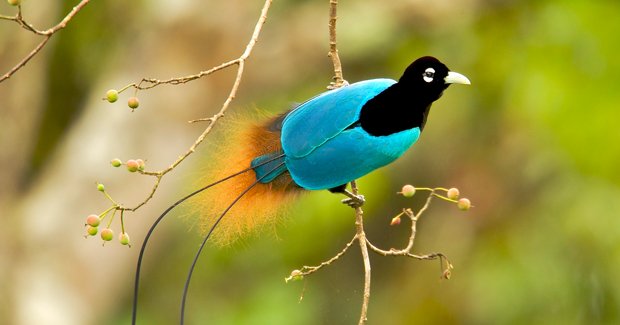Unusual Mating Rituals in the Animal Kingdom
The animal kingdom is filled with fascinating behaviors, especially when it comes to courtship and mating. These rituals are not only essential for the continuation of species but also showcase the incredible diversity and complexity of animal behavior.
From elaborate dances to dangerous sacrifices, the mating rituals of animals can be both bizarre and intriguing.
This article explores some of the most unusual mating rituals in the animal world, highlighting how these behaviors have evolved to ensure reproductive success.
The Dance of the Birds of Paradise
 Birds of Paradise, native to New Guinea and surrounding islands, are renowned for their spectacular plumage and intricate courtship dances.
Birds of Paradise, native to New Guinea and surrounding islands, are renowned for their spectacular plumage and intricate courtship dances.
These birds exhibit some of the most elaborate mating displays in the animal kingdom, which often involve intricate movements, vibrant colors, and unique sounds.
- Courtship Displays: Male Birds of Paradise use their striking plumage and elaborate dances to attract females. Each species has its unique display, which may include spreading feathers, hopping, swinging, or even hanging upside down. The purpose of these displays is to demonstrate the male's health, vitality, and genetic fitness.
- Female Choice: Female Birds of Paradise are highly selective, often choosing mates based on the quality and complexity of their displays. This intense sexual selection has driven the evolution of increasingly elaborate and extravagant displays among males.
- Evolutionary Significance: The elaborate displays of Birds of Paradise are an example of sexual selection, where traits that are advantageous for attracting mates become more pronounced over generations. These displays highlight the role of female choice in shaping the evolution of species.
The Bowerbird's Architectural Mastery
Bowerbirds, found in Australia and New Guinea, are another group known for their unique mating rituals, particularly their construction of intricate structures called bowers.
These structures are not nests but rather elaborate displays used to attract females.
- Building the Bower: Male bowerbirds build and decorate bowers with great care, using materials such as sticks, leaves, feathers, and even human-made objects like plastic and glass. The design and decoration of the bower can vary significantly between species, with some creating intricate avenues, while others build elaborate huts.
- Decoration and Presentation: The choice of materials and the aesthetic arrangement play a crucial role in attracting females. Males will often steal decorations from neighboring bowers, indicating the high stakes involved in this form of courtship.
- Mating and Selection: Females visit multiple bowers, inspecting the quality and creativity of each before choosing a mate. The bower's appearance and the male's display at the bower site are critical factors in her decision, demonstrating the importance of visual and behavioral cues in mate selection.
The Risky Business of Male Redback Spiders

- Self-Sacrifice for Mating Success: During mating, male redback spiders often engage in a behavior known as "sexual suicide," where they somersault into the jaws of the female. This seemingly self-destructive act increases the likelihood of the male being eaten after copulation.
- Cannibalism and Reproductive Success: The act of being consumed by the female appears to increase the chances of successful fertilization. Females that consume their mates are less likely to mate again, ensuring the male's genetic contribution. Additionally, the nutrients provided by the male's body may benefit the female and her future offspring.
- Evolutionary Strategy: While this behavior may seem counterintuitive, it is an evolutionary strategy that maximizes the male's reproductive success. By increasing the chances of fertilizing the female's eggs and reducing the likelihood of her mating with other males, this strategy ensures the propagation of the male's genes.
The Enigmatic Mating of Seahorses
Seahorses exhibit one of the most unusual mating systems in the animal kingdom, where males become pregnant and carry the developing offspring. 
This reversal of traditional gender roles in reproduction is a unique adaptation that has intrigued scientists.
- Courtship and Bonding: Seahorse courtship involves elaborate dances and changes in coloration. Couples engage in synchronized movements and may wrap their tails around each other, strengthening their bond. This courtship can last for several days and helps establish a strong pair bond.
- Male Pregnancy: Unlike most other species, male seahorses have a specialized brood pouch where females deposit their eggs. The male fertilizes the eggs inside this pouch and carries them until they hatch. This adaptation allows the female to recover quickly and produce more eggs, thereby increasing reproductive efficiency.
- Parental Care: Male pregnancy in seahorses also involves providing oxygen and nutrients to the developing embryos. Once the young are ready, the male goes into labor, expelling fully formed miniature seahorses into the water. This unique reproductive strategy highlights the diverse ways in which animals adapt to their environments.
Conclusion
The animal kingdom's diversity extends far beyond appearances, encompassing a wide range of mating rituals that reflect the complexity of evolutionary strategies. From the colorful displays of Birds of Paradise to the architectural prowess of bowerbirds, the self-sacrifice of redback spiders, and the unique male pregnancy of seahorses, these rituals illustrate the varied approaches to reproduction. Understanding these behaviors not only provides insight into the natural world but also underscores the importance of adaptation and selection in the evolution of species.
Sources
- National Geographic: Birds of Paradise
- BBC: The Dark Side of Spider Sex
- National Geographic: The Risky Mating Strategy of Male Redback Spiders
- National Geographic: The Fascinating Mating Rituals of Animals

































